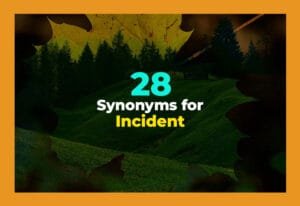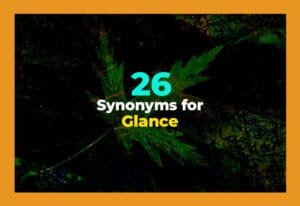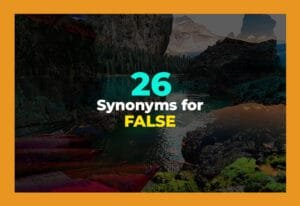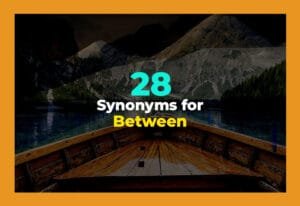You've probably used the word "policy" a lot, right? But sometimes, it's good to mix things up a bit and use other words that mean the same thing. This can make your writing sound more interesting and precise. Whether you're writing for work, school, or just chatting, having different ways to say "policy" can really help.
1. Guideline
A “guideline” is like a rulebook but with a little more flexibility. It's a general recommendation or principle that helps steer actions. For example, a company might have a dress code guideline instead of a strict policy, giving employees room to express their style within limits. While guidelines are helpful, they aren’t as rigid as formal rules. It's more about providing direction without saying "you must do this." An example would be a health organization's guideline for maintaining a healthy lifestyle, advising on diet and exercise but not enforcing it like a strict policy.
2. Rule
A “rule” is a clear, specific instruction that must be followed. Unlike guidelines, rules are stricter and have consequences if they're broken. Think of school rules – no running in the hallways. These rules are put in place to keep things running smoothly and safely. For example, a rule at a library could be no talking loudly, ensuring everyone can concentrate. A rule is a must-follow thing, unlike a policy that might have room for some interpretation. It's straightforward, and breaking it often results in a penalty.
3. Regulation
A “regulation” refers to a formal rule, often set by a government or organization to control behavior. Regulations are usually put in place to ensure safety or fairness in different environments. For example, environmental regulations might require factories to limit the amount of pollution they release. Another example could be safety regulations in a workplace, ensuring that employees work in a safe and healthy environment. These are official and typically backed by law or formal authority, so they carry a lot of weight.
4. Strategy
A “strategy” is more of a planned approach or method to achieve a goal. It's like setting a map for the journey you're about to take. For example, a business might create a marketing strategy to reach more customers. This isn't a rule or a guideline but more of a thoughtful plan of action. A strategy focuses on the big picture and how to best reach an objective. It's often flexible and can change based on new information or circumstances, unlike a strict policy or rule.
5. Protocol
A “protocol” is a set of steps or procedures that must be followed in specific situations, often for safety or efficiency. Think of it like a set of instructions to make sure everything goes correctly. For example, hospitals have a protocol for dealing with emergencies to save lives. Another example might be diplomatic protocol, which sets rules for how countries interact. Following a protocol ensures that everything runs in an organized, effective way, especially in formal or high-stakes situations. It's more structured than a guideline but less strict than a policy.
6. Procedure
A “procedure” is a series of actions or steps taken to accomplish something. It's often used in workplaces or institutions to ensure tasks are completed in an organized and consistent way. For example, a company might have a procedure for handling customer complaints, so everyone knows what steps to take when an issue arises. Another example could be a medical procedure, where doctors follow specific steps to ensure a patient's health is cared for in the best way. Procedures are detailed and methodical, ensuring that things are done right.
7. Framework
A “framework” is a structure or system that provides support and guidelines for making decisions. It's like a skeleton that supports the overall function of something. For example, a government might have a legal framework that guides how laws are made and applied. Another example could be an educational framework, which helps shape how teaching is done in schools. Frameworks don't usually provide detailed rules but set up the structure within which things should happen. It's more like a support system to guide actions.
8. Doctrine
A “doctrine” is a set of beliefs or principles that guide actions. Often used in religious, political, or military contexts, a doctrine outlines how things should be done based on specific beliefs. For example, a country’s foreign policy might be based on a certain political doctrine, guiding how they interact with other nations. Another example could be a company's corporate doctrine, reflecting its values and how it operates. Doctrines are typically broad, guiding principles that shape decisions and actions in different areas of life.
9. Code
A “code” is a system of rules or principles, often written down, that guides behavior. Codes are usually a little more formal and structured than guidelines. For example, a lawyer must follow a code of ethics to ensure they're acting in the best interest of their clients. Another example could be a building code, which sets standards for the design and construction of buildings to ensure safety. Codes are important because they help maintain standards and protect everyone involved. They're like a detailed set of instructions for how to act in specific situations.
10. Agenda
An “agenda” is a list or outline of things to be discussed or accomplished. It's often used for meetings or events to ensure everything is covered. For example, a manager might create an agenda for a team meeting, listing topics to be discussed like performance reviews or upcoming projects. Another example might be a conference agenda, laying out the schedule for speakers and sessions. An agenda helps keep things organized and ensures that nothing is forgotten. While it's not as strict as a policy, it serves as a guide for what should happen.
11. Plan
A “plan” is a detailed proposal for doing something. It's like a roadmap showing the steps needed to reach a goal. For example, a city might have a plan for building new public parks to improve the community. Another example could be a travel plan, where you outline your trip details, like where you'll go and when. Plans are often flexible and changeable, depending on circumstances. They're not as fixed as a policy but provide direction on how to approach tasks or objectives in a structured way.
12. Framework
A “framework” is a basic structure that helps you understand or approach a certain task or topic. It's more like a blueprint or a skeleton of how something works. For example, a teacher might use a teaching framework to decide how lessons are structured. Another example could be a legal framework that guides how courts make decisions based on laws. Frameworks are useful because they give you a foundation to build upon but leave room for flexibility in how things are done. They provide general guidance rather than specific instructions.
13. Standard
A “standard” is an agreed-upon level of quality or performance that is expected in a particular area. Standards help ensure that things are done the right way, but they can vary by industry or location. For example, the standard for making sure food is safe to eat is set by food safety guidelines. Another example could be a company setting a standard for customer service, like how quickly they respond to emails or calls. Standards help maintain consistency and quality, ensuring that people or organizations meet expected levels of performance.
14. Norm
A “norm” refers to the usual or expected way of doing things in a particular group or society. It's what people typically do or believe is acceptable. For example, in many countries, a social norm is shaking hands when meeting someone new. Another example could be the workplace norm of arriving on time for meetings. Norms are important because they help people know what is expected in certain situations. They are often unwritten rules that guide behavior, although they can be influenced by laws or formal policies in some cases.
15. Law
A “law” is a rule established by the government or another authority to regulate people’s behavior. Laws are mandatory, and breaking them usually leads to legal consequences. For example, traffic laws require drivers to stop at red lights to ensure everyone's safety. Another example could be a law requiring businesses to pay taxes. Laws differ from policies because they are enforceable by legal action and have clear, defined penalties for those who break them. Policies, on the other hand, may not have the same legal consequences.
16. Instruction
An “instruction” is a detailed explanation of how to do something. It's often a step-by-step guide to help someone complete a task correctly. For example, a recipe provides instructions on how to cook a dish. Another example could be a set of instructions on how to use a new piece of equipment at work. Instructions are often straightforward and easy to follow, providing clarity on how things should be done. They're not as broad as policies but are essential for completing specific tasks or achieving a particular outcome.
17. Direction
“Direction” refers to the guidance or advice given to help someone achieve a goal. It's not about strict rules but more about offering a path to follow. For example, a coach might give direction to their team on how to improve their strategy during a game. Another example might be a boss giving direction on how to approach a new project. Directions are typically flexible, and they help individuals stay on track without being overly controlling. It's more about guiding the overall approach than laying down rigid rules.
18. Manual
A “manual” is a detailed book or guide that provides instructions or explanations for how to use something. For example, a car comes with a manual that tells you how to maintain and fix it. Another example could be a user manual for a smartphone, guiding you on how to set up your device. Manuals are often thorough, providing all the information you need to understand or operate something. While they're similar to instructions, manuals tend to be more comprehensive, covering a wide range of topics related to the subject.
19. Custom
“Custom” refers to a practice or tradition that is specific to a particular group or society. It's often based on long-held beliefs or habits. For example, in some cultures, there is a custom of giving gifts during holidays. Another example could be a custom of shaking hands when meeting someone new in business settings. Customs can influence policies or behaviors, but they're usually not formalized. They are more about tradition and shared values within a specific community or group.
20. Practice
A “practice” is a repeated action or custom that is followed regularly. It's something that people do as part of their routine. For example, a practice in some offices is having weekly team meetings to stay updated on projects. Another example could be the practice of going for a morning jog to stay fit. Practices can often shape policies if they become consistent and widely accepted. They're less formal than policies but still guide how things are done regularly.
21. Constitution
A “constitution” is a document or system that sets out the fundamental principles and rules of an organization or country. It defines the structure and how decisions are made. For example, the U.S. Constitution outlines how the government should operate. Another example could be the constitution of a university, which might include rules for how students and staff should behave. Constitutions provide the backbone for policies and laws, ensuring everything is in place for how things should function on a large scale.
22. Vision
A “vision” is a forward-thinking, broad statement of what an organization or person hopes to achieve. It's less about rules and more about the desired outcome. For example, a company might have a vision to become the leader in its industry. Another example could be a non-profit having a vision to eliminate hunger worldwide. Visions guide long-term goals and decision-making, offering a clear picture of the future. They may inspire policies but are more focused on the big picture of what to achieve, not the specific steps.
23. Objective
An “objective” is a specific goal or target that someone is trying to reach. It's more about having a clear purpose rather than a set of rules. For example, a student might set an objective to finish their homework by 8 PM. Another example could be a team setting an objective to finish a project on time. Objectives are concrete and measurable, giving clear targets to aim for. They guide actions but aren't as broad as policies because they focus on achieving specific results.
24. Principle
A “principle” is a fundamental truth or belief that guides actions and decisions. It's a basic idea that influences behavior but is more abstract than a policy. For example, a company might have a principle of honesty, guiding how employees interact with customers. Another example could be the principle of fairness, which drives decisions in many organizations and schools. Principles are important because they provide the ethical or moral foundation for policies and decisions, influencing how things are done on a deeper level.
25. Initiative
An “initiative” is a project or action that's undertaken to achieve a specific goal. It often starts with a desire to improve or change something. For example, a city council might launch an environmental initiative to reduce waste. Another example could be a company's initiative to improve employee wellness. Initiatives are about taking action to create change, often leading to new policies or practices. They're not as formal as policies but are an important part of driving progress in any organization or community.
26. Approach
An “approach” is a way of dealing with a situation or problem. It's a method or strategy to solve something. For example, a teacher might take a hands-on approach to teaching, letting students learn by doing. Another example could be a company adopting a customer-centric approach, focusing on the needs of their customers. Approaches aren't as formal as policies but guide actions. They are flexible, allowing for different ways to tackle challenges or reach goals.
27. Tactic
A “tactic” is a specific action or step taken to achieve a goal, often as part of a larger plan. For example, a sports team might use a defensive tactic to win a game. Another example could be a company using social media tactics to increase brand awareness. Tactics are focused on getting results in the short term, while policies are broader and more long-term. They provide concrete steps to reach specific objectives and are often flexible depending on the situation.
28. Plan
A “plan” is a detailed proposal for how to do something, similar to a strategy but often more focused on specific actions. For example, a business might create a marketing plan to launch a new product. Another example could be a family's vacation plan, detailing where they'll go, what they'll do, and when. Plans can change depending on circumstances but are an important part of achieving goals. They break down larger objectives into manageable tasks and steps.
29. Arrangement
An “arrangement” refers to an organized agreement or system of things. It can refer to both informal and formal agreements that help things function. For example, a work arrangement could allow someone to work from home a few days a week. Another example could be the arrangement of flowers in a vase, organizing them to look attractive. Arrangements can be made for almost anything and are flexible depending on the situation.
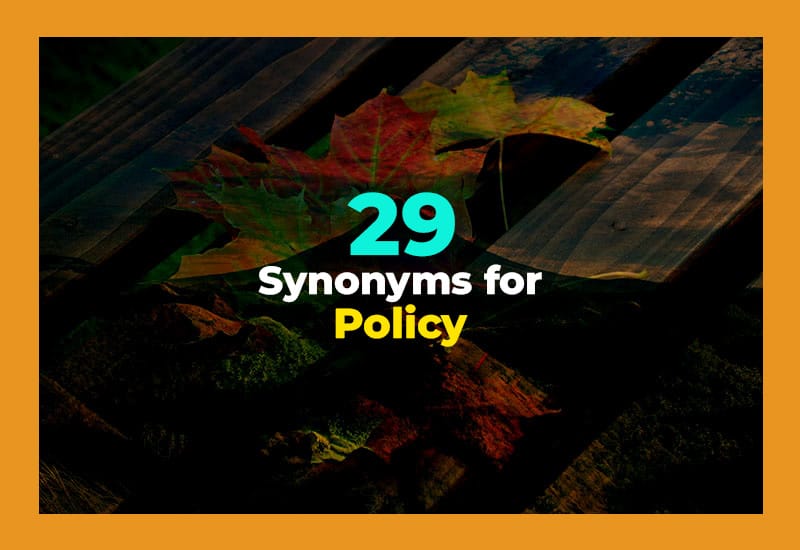
I hope this list of synonyms for “policy” gives you a new way to look at your vocabulary! Whether you're writing a report or just chatting with friends, you'll find that these words can make what you're saying sound fresh and interesting.

